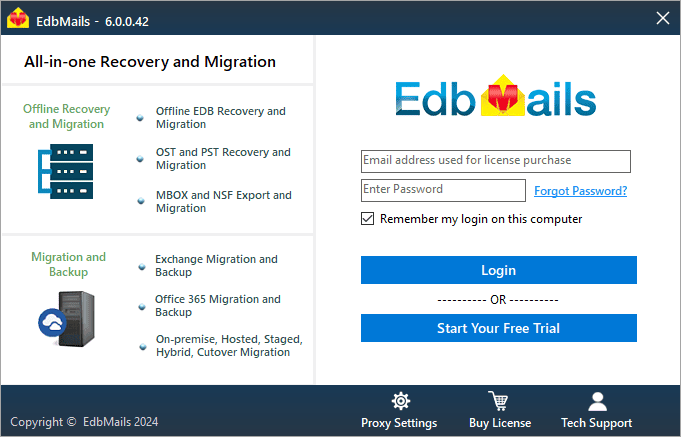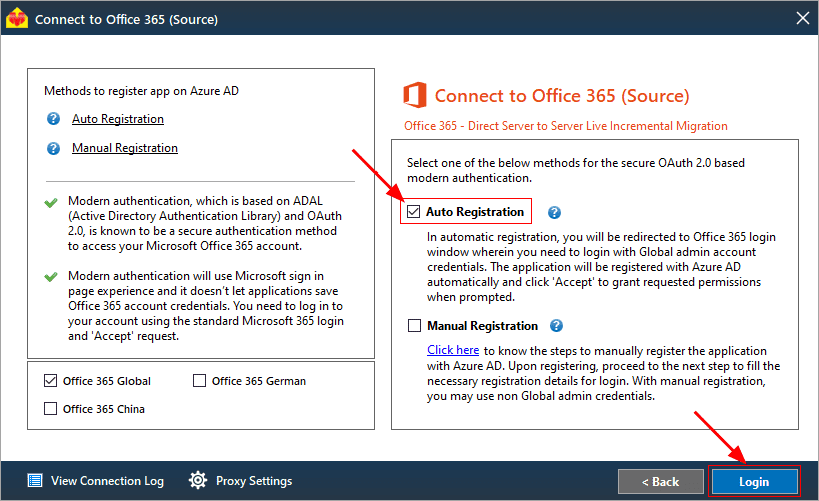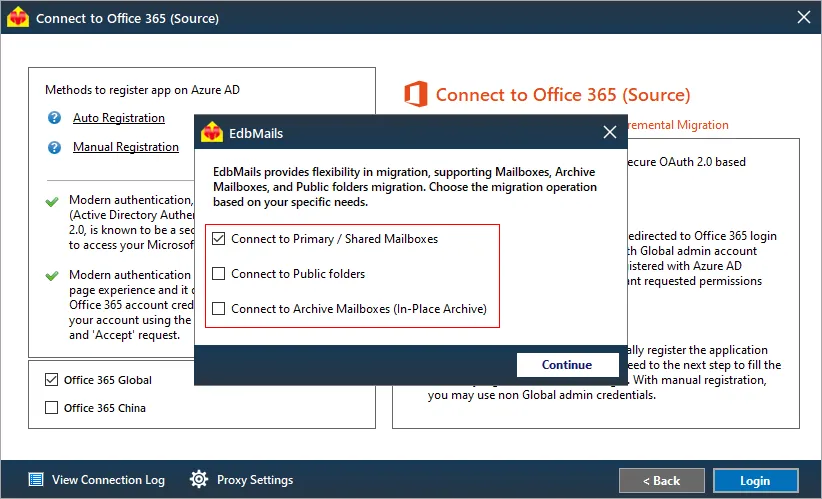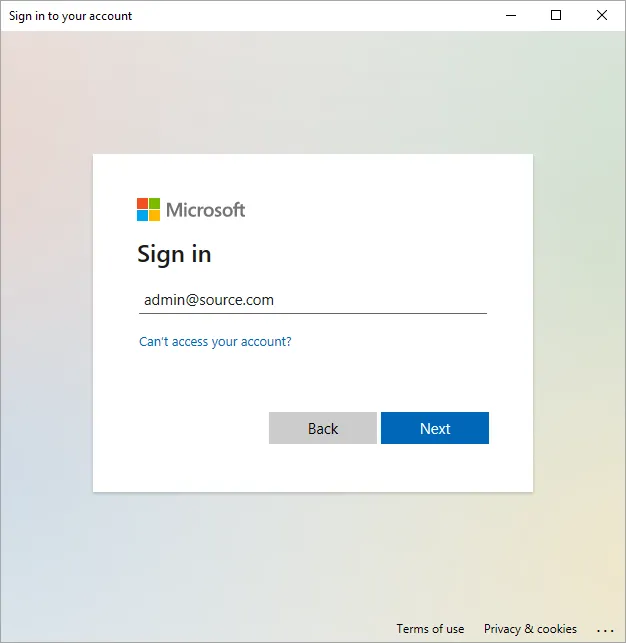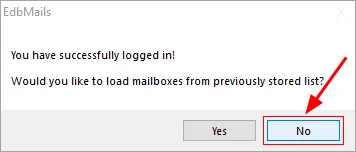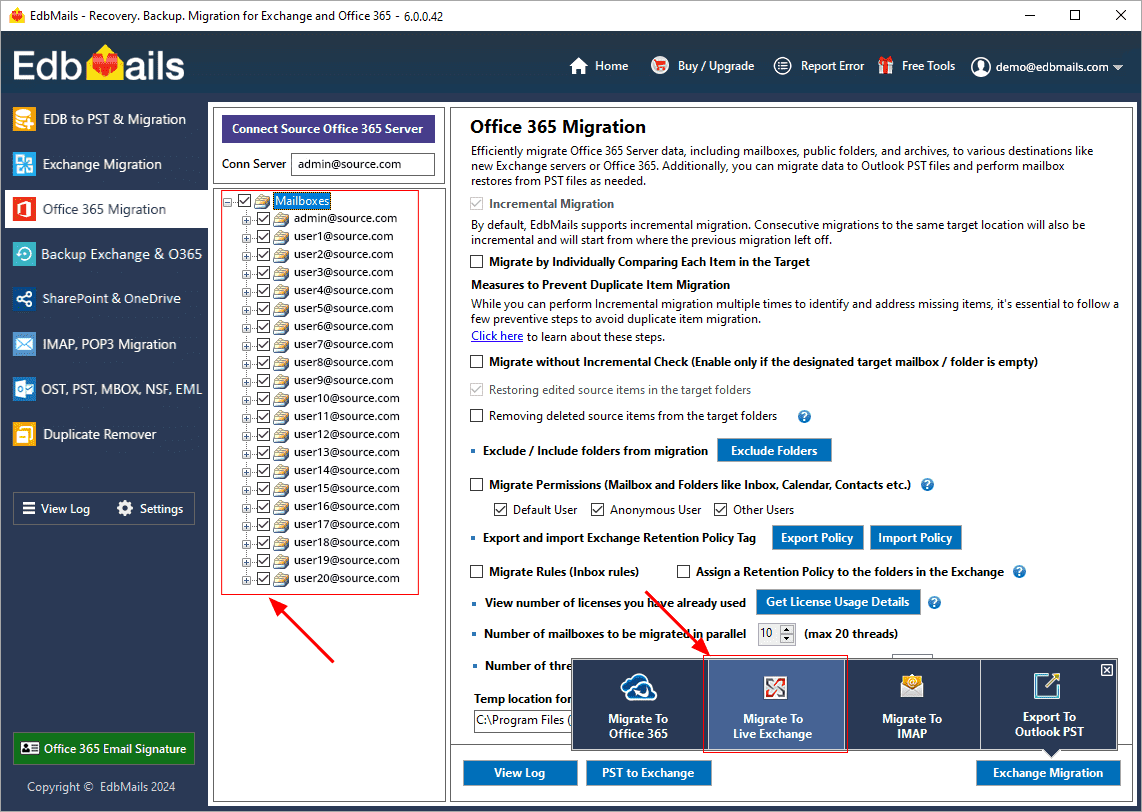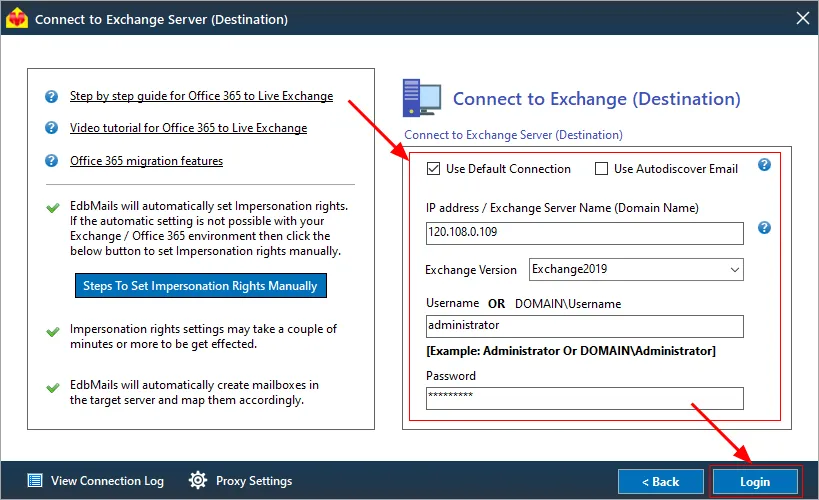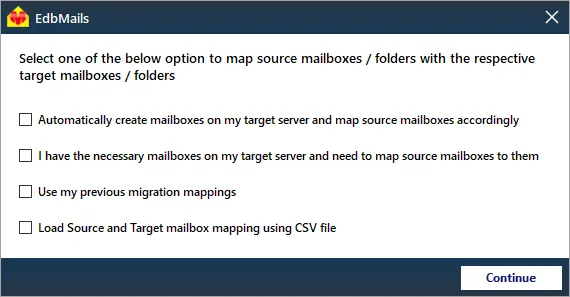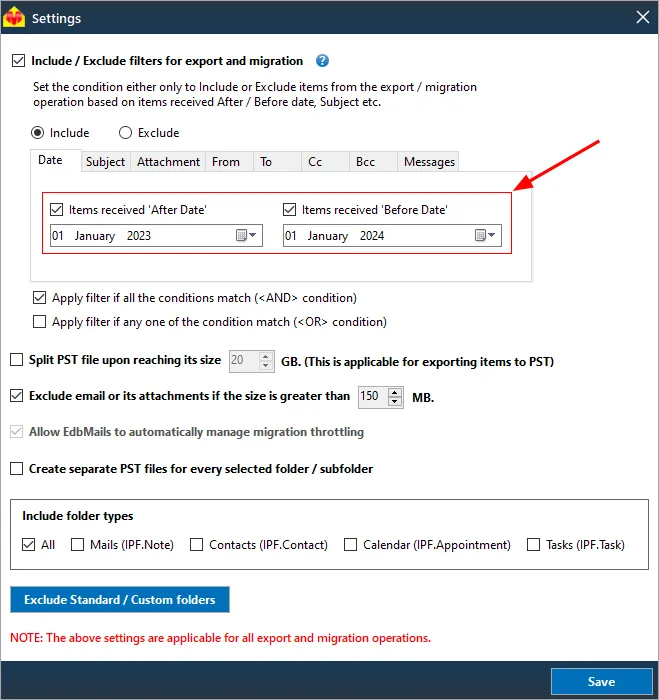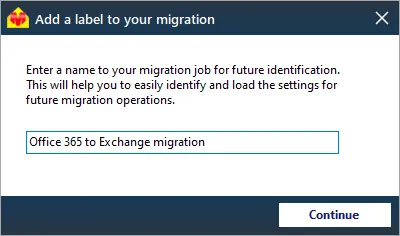Office 365 to on-premises Exchange migration
Office 365 to on-premises Exchange server migration can address various needs. This transition provides greater control over email management, allowing for tailored customization and seamless integration with other internal systems. It also meets specific regulatory and compliance requirements related to data sovereignty and security, which may be more challenging to manage in a cloud environment. Additionally, moving to an on-premises server can help reduce long-term subscription costs and offer more direct oversight of data performance and security.
EdbMails Office 365 Migration software provides the direct solution for migrating mailboxes, public folder folders, archive mailboxes and shared mailbox data from Exchange Online to an on-premises Exchange server. The software simplifies the migration by removing the need for a hybrid setup or the cumbersome PST import/export process. EdbMails supports direct migrations from Office 365 (Microsoft 365) to Exchange 2007 and later versions, including the latest Exchange 2019, ensuring a smooth migration.
The software copies data without altering the original source mailboxes and maintains the folder structure in the target mailbox. With its intuitive, user-friendly interface, EdbMails makes the migration process straightforward and efficient. You can avoid PowerShell scripting and minimize downtime, resulting in a smooth migration experience.
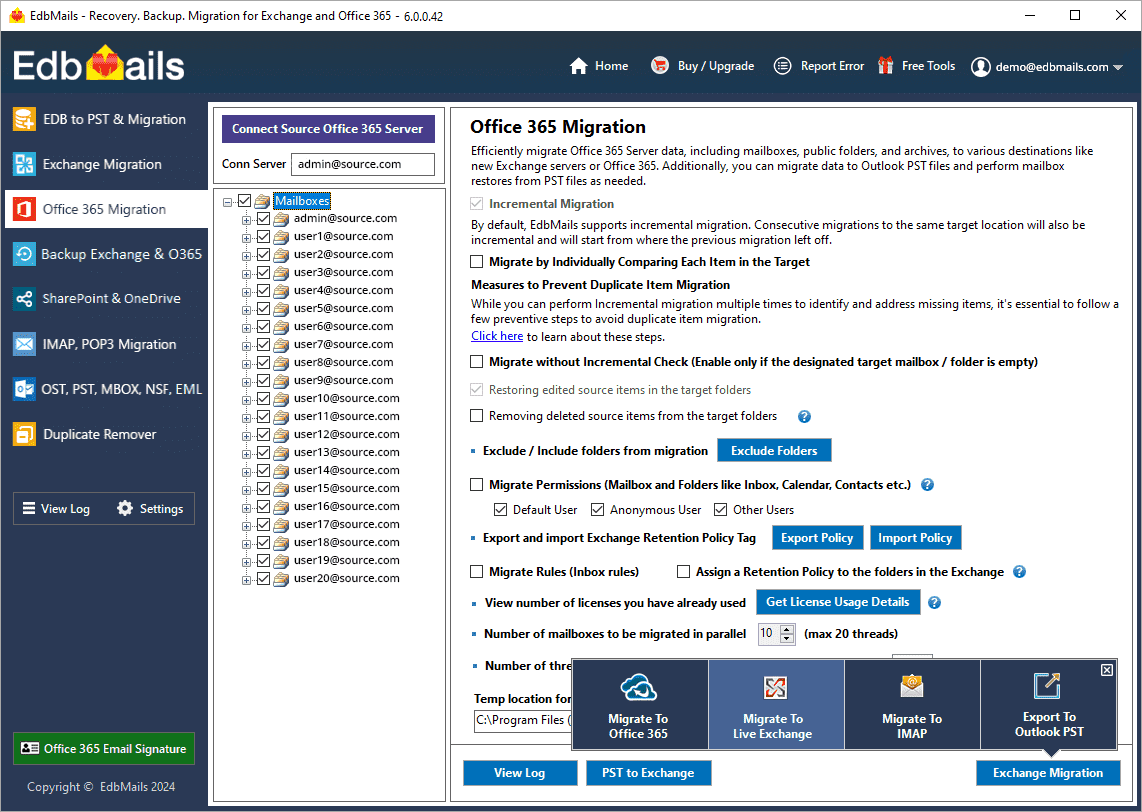
Office 365 to Exchange migration plan
The most important aspect of the migration is planning. A good plan saves time and makes the operation run smoothly and without stress. Here is a checklist of the most important factors to consider when migrating from Office 365 to on-premise Exchange.
- Prepare a complete inventory of items that you want to migrate from Office 365.
- Determine if you want to follow the cutover migration, staged or hybrid migration method.
- Determine if you want to migrate Public folders and Shared mailboxes to the target along with the primary mailbox.
- Determine the size of the mailbox data and number of mailboxes to migrate.
- Communicate any changes to your end users and inform the stakeholders.
- Prepare the domains and required Active Directory services on the target.
- Create mailboxes and Public folders on the target Exchange server
- Assign suitable licenses to the mailboxes.
- Ensure you have enough network capacity and bandwidth to migrate.
- Consider the throttling and message size limits on the Exchange server.
- Perform a test (pilot) migration before you start the actual one
- Start the migration, verify the endpoint and add the DNS records.
- Create new Outlook profiles for the users and check if you are receiving mails correctly
- Remove the permissions and licenses on the source Office 365 tenant.
Pre migration activities for Office 365 to Exchange migration
- Step 1: Check that you meet the following requirements on Office 365
- Decide the migration path you want to take depending on your environment either cutover or staged or migration in a hybrid environment.
- Ensure to have global admin access for Auto Registration of the EdbMails application on your Entra ID (Azure Active Directory). If you prefer Manual Registration, you can use a global admin account or any user account with full access rights.
- Ensure that you meet the network and bandwidth requirements for the migration. See network and migration planning, performance factors and best practices for Office 365 migration.
- Step 2: Check that your system meets the Exchange server setup requirements.
The following links will help you set up your target Exchange server environment based on the Exchange version you want to migrate to. Learn more about the network, hardware and operating system requirements for installing Exchange server.
Note: Exchange 2010 reached the end of support on October 13, 2020 and Exchange 2013 reached the end of support on April 11, 2023. Therefore it is highly recommended that you migrate your mail data and Public folders to Exchange 2016 or 2019.
- Step 3: Prepare your target system with the following prerequisites
Complete the following prerequisites for Active Directory, Windows Mailbox server, and Windows Edge Transport servers before installing the Exchange server.
- Step 4: Set up Exchange Server for migration
Here is a list of essential steps for installing and preparing the Exchange server for migration.
- Prepare AD and domains
- Before installing Exchange server you need to prepare your Active Directory forest and its domains for the new version of Exchange.
- If you have a separate team to manage the Active Directory schema, you need to first extend the active directory schema, else proceed to the next step to prepare the Active Directory.
- If you have multiple domains you need to additionally prepare the Active Directory domains.
- Install Exchange server on your computer
Before installing the Exchange server, ensure that you meet the Exchange server system requirements and prerequisites as outlined previously. Next, follow the link to install Exchange 2016 or install Exchange 2019 from the setup wizard.
- Prepare a clean Exchange target environment
- Create and configure a Send connector to send mail outside the Exchange organization.
- By default, Exchange automatically creates receive connectors for inbound mail flow when the mailbox server is installed. If you need to configure receive connectors, follow the steps in the link.
- Add accepted domains to allow recipients to send and receive email from another domain.
- Configure the default email address policy to add the accepted domain to every recipient in the organization.
- Configure external URLs (domains) on the virtual directories in the Client Access (frontend) services on the Mailbox server to allow clients to connect to your server from the internet (outside the organization’s network).
- Configure internal URLs on the virtual directories in the Client Access (frontend) services on the Mailbox server to allow clients to connect to your server from the internal network.
- Configure SSL certificates from a third-party certificate authority for services such as Outlook Anywhere and Exchange ActiveSync.
- Verify the Exchange server installation by running the command Get-ExchangeServer on the Exchange Management Shell (EMS).
- Create mailboxes and Public folders on the Exchange server
Ensure that mailboxes are created on the target Exchange server. EdbMails automatically creates mailboxes, but if you prefer to create mailboxes manually, follow the steps for creating mailboxes on the Exchange server. If you're planning a Public folder migration from Office 365 to Exchange, refer to the steps for creating Public folders and assign admin permissions on the Exchange server.
- Set impersonation rights to global Admin account
If you are connecting to the Exchange server using a global admin account, ensure that impersonation rights are set to allow the migration of all other mailboxes.
Refer to the steps to set impersonation rights for a global admin account on the Exchange server.
- Verify the Admin account mailbox
Ensure that the admin account assigned management roles has an active and visible mailbox on the Exchange server.
- Manage throttling and message size limits
- If the migration is being throttled by Microsoft, set the custom throttling policies on the Exchange server.
- If large messages are causing migration delays, increase the message size limits to the maximum on the Exchange server.
- Prepare AD and domains
- Step 1: Check that you meet the following requirements on Office 365
Methods to perform Office 365 to Exchange migration
You can migrate Office 365 to on-premise Exchange server with the following methods:
- Method 1: Office 365 to Exchange cutover migration
- Method 2: Batch or staged migration from Office 365 to on-premise Exchange server
- Method 3: Office 365 to Exchange Hybrid migration
- Method 1: Office 365 to Exchange migration using cutover method
- Step 1: Download and install EdbMails Office 365 migration software
- Download EdbMails and install the application on the source computer.
- The application is compatible with all Windows server and client operating systems.
See a detailed list of EdbMails system requirements for Office 365 to on-premises Exchange migration.
- Step 2: Launch EdbMails software
- Enter the email address & password and click the 'Login' button or click the 'Start Your Free Trial' button to access the EdbMails application.
- Step 3: Select 'Office 365 Migration'
- Select the migration option as ‘Office 365 Migration’.
- Step 4: Connect to the source Office 365 server
In the ‘Connect to Office 365 (Source)’ window, choose the appropriate method for secure OAuth 2.0-based modern authentication. The default ‘Auto Registration’ method requires Global admin access. Alternatively, the Manual Registration method allows you to use either a Global admin account or any user account with full access rights.
EdbMails supports the migration of mailboxes, public folders, and archive mailboxes from Office 365 to an on-premises Exchange server. Select the required migration operation and proceed.
Sign in on the Microsoft authentication page using a global admin account.
If you have previously established an Office 365 connection with EdbMails, the list of mailboxes will be saved and can be reused. For a new connection, click the ‘No’ button to access options for loading mailboxes.
EdbMails automatically retrieves mailboxes from your source Office 365 server. If the automatic loading option does not display the required mailboxes, you can use a CSV file to load the mailboxes. Alternatively, you can load mailboxes from a previously saved list.
- Step 5: Select the Office 365 mailboxes
Select the mailboxes that you want to migrate from the left pane
Click ‘Migrate to Live Exchange’ to establish a connection with the target server.
- Step 6: Connect to target Exchange server
In the 'Connect to Exchange (Destination)' window, choose the necessary connection options and click 'Next'. If using a global admin account, ensure that impersonation rights are set.
Click here to learn more about the different methods to connect to the Exchange server in EdbMails.
With EdbMails, you can migrate mailboxes, public folders, and archive mailboxes from Microsoft 365 to Exchange server.
Enter the Exchange server details and click the ‘Login’ button
If a live Exchange connection has already been set up with EdbMails, the list of mailboxes will be saved for future use. To establish a new connection, click the ‘No’ button to access options for loading mailboxes.
EdbMails automatically retrieves mailboxes from your target Exchange server. If the automatic retrieval does not include the mailboxes you need, you can load the mailboxes using a CSV file. Alternatively, you can load mailboxes from a previously saved list.
- Step 7: Map source and target mailboxes
Choose the required mailbox mapping option
If you have installed EdbMails on your Exchange server, you can choose the option to automatically create mailboxes on the target Exchange server.
Click here to know more about automatic mailbox creation
Click here to know about user-defined mailboxes / folders mapping
EdbMails automatically maps mailboxes and folders between the source and target servers, which is especially useful for large migrations. Alternatively, you can manually map source folders and subfolders to designated target locations if needed.
EdbMails offers folder and item filters to customize your migration task. You can migrate data within a specific date range and apply additional filters such as from address, to address, cc address, bcc address, attachment names, and the read/unread status of messages.
- Step 8: Start Office 365 to on-premises Exchange migration
After completing the mailbox mapping, click the ‘Continue’ button and enter the job name and proceed
The migration process has started. Once it is complete, a message will be displayed. You can click the 'View Log' button to view the migration report.
- Step 1: Download and install EdbMails Office 365 migration software
- Method 2: Office 365 to Exchange server staged migration
Staged migration involves transferring mailbox data in two or more stages, making it suitable for medium to large enterprises with a substantial amount of data that cannot be migrated overnight or during a weekend, as is possible with cutover migration.
The migration process is typically divided into different phases, based on a specified date:
- First stage: Migrate data that is either older or newer than the specific date using date filters
- Subsequent stages: Migrate the remaining data.
First stage:
Refer to the Step 1 to Step 8 from the cutover migration method as explained in the previous section. Next, click the 'Folder and filter items' button in the mapping window and apply the filter according to your requirements. For example, if you want to migrate recent emails first, select the 'After Date' filter option and choose the date from the date picker.
Start the migrationSecond Stage:
After completing the first stage, reconnect to the source and target servers using the existing connection. Remove the ‘After Date’ filter, set the ‘Before Date’ filter, and select the required date from the date picker to migrate the remaining items.
In a staged migration, changing the source or target email addresses after completing the first stage may cause item duplication. If you need to change the source or target email addresses after the first stage, it is recommended to create alias email addresses for both the source and target server mailboxes before the first stage of migration. Then, load the mailboxes using a CSV file and proceed with the subsequent migrations.
- Method 3: Office 365 to Exchange Hybrid migration
If you plan to migrate mailboxes within an on-premises Exchange server and Office 365 environment, a Hybrid migration is the best solution.
Refer to the Office 365 Hybrid migration planning guide with EdbMails for detailed migration steps.
If your mailboxes are in a Hybrid environment, you cannot migrate Public folders directly from Office 365, as they cannot concurrently exist on both Exchange Online and on-premises servers. See a workaround solution for migrating Public folders in a Hybrid environment.
Post-migration Activities
The following steps apply only if you no longer wish to use Office 365 and want to switch to on-premises Exchange permanently.
- Step 1: Update the MX records to point to the Exchange server
To receive messages on the Exchange server, change the DNS records to enable email to work with the new server you have migrated to. In addition, configure the Autodiscover record to allow Outlook to connect to the migrated mailboxes.
- Step 2: Create a new Outlook profile for users in the new domain
- Ensure you have the latest version of Outlook installed to avoid compatibility issues.
- Configure the Outlook profile for each user in your domain if Outlook has problems connecting to Office 365 mailboxes.
- Configure the new server settings, such as the server address, username, and password in Outlook.
- Test email flow to ensure that your users are able to send and receive emails.
- Step 3: Remove the old Office 365 subscription plan
After the migration is successful and you have verified the data, remove the Office 365 subscription plan from the source and any domains associated if you no longer plan to use it
- Step 1: Update the MX records to point to the Exchange server
Office 365 migration troubleshooting
See the troubleshooting solutions for Office 365 and Exchange migration. For more information related to EdbMails Office 365 migration, see frequently asked questions.
Benefits of EdbMails for Exchange online to Exchange migration
- Migrate Office 365 to Exchange server 2019, 2016, 2013 and 2010.
- Support for cutover, staged, hybrid and PST to Exchange migration methods.
- Zero downtime and zero data loss Office 365 to Exchange migration.
- EdbMails is an all-in-one migration tool that supports GoDaddy to Office 365 migration and also enables you to migrate Rackspace to Office 365.
- You do not have to use PowerShell scripts and cmdlets for transferring your mailbox data.
- Migrate Public folder, In-Place Archive and Shared mailboxes
- Highly secure migration with complete data consistency.
- EdbMails enables you to use your mailboxes even during the migration without affecting your data.
- Monitor and verify the migration with migration reports.
- Direct connection and automatic mailbox mapping between the source and target.
- Automatically creates mailboxes on target server
- Free 24x7 technical support to assist you with the migration operation.
Additional resources:
- Video - Office 365 to Exchange migration
- Automatically create mailboxes on target Exchange server
- Automatic mailbox mapping between source and target servers
- Set impersonation rights on target Exchange server
- Avoid throttling on Exchange server
- Archive mailbox to Exchange migration
- Migrate Office 365 to Exchange 2019
- Office 365 to Hosted Exchange migration



